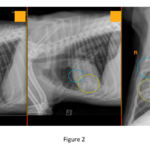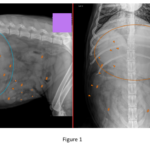scott@vtx-cpd.com
Forum Replies Created
-
AuthorPosts
-
Hey Helen!
I hope you are well. Welcome to the course. We really appreciate your support and for choosing vtx!
Let us know if you have any other questions, or even feedback/suggestions for the course.
Have a great weekend.
Scott 🙂
Thanks Tori.
Interesting questions. Even I remember seeing lots of these cases when I worked at the PDSA many years ago!
Overrepresented in Rottweilers?
Scott 🙂
Replying to Kerry Doolin 22/08/2025 - 01:09
Thank you Kerry!
So interesting. Thanks for sharing the links.
Scott 🙂
Hi Aileen,
Based on her presentation and rapid full recovery, Border Collie Collapse (BCC) remains the most likely diagnosis.
Storm’s episode, featuring generalized ataxia, altered mentation, heavy panting, and congested mucous membranes, would understandably signal potential heat stroke, particularly with a recorded temperature of 40.3 °C. Initiating cooling measures and monitoring were the right steps. Yet, when you consider the moderate environmental temperature (muggy ~18 °C), the short exercise duration, and her swift return to normal, the features don’t align with typical exertional hyperthermia. Instead, they mirror what we know of BCC, a condition that tends to be triggered more by mental arousal and excitement than by heat or the length of exercise.
Distinguishing between early heat-related illness and BCC at initial presentation can be very challenging—both can present similarly, and early hyperthermia is common in both. Treating cautiously as a heat-related emergency is entirely appropriate in the acute setting. Over time, however, the pattern becomes clearer: BCC episodes are often reproducible, self-limiting, and occur within very specific contexts, with rapid recovery and no lasting neurological or systemic compromise. Detailed history remains your most powerful diagnostic tool.
You mentioned prior, milder wobbliness—these could very well have been partial expressions of BCC. Consistent context, lack of progression, and normal inter-episode exams reinforce BCC. Dogs affected by BCC typically do well in structured settings, such as agility, where arousal is managed and activities are controlled.
Regarding investigations: there remains no commercially available genetic test for BCC in Border Collies. The available DNM1/EIC test, offered by Laboklin and others—is specific to Labrador-type collapse and is not applicable to Border Collies. Laboklin’s genetic panel for Border Collies includes tests for conditions like CEA, MDR1, Sensory Neuropathy, and Trapped Neutrophil Syndrome, but does not cover BCC.
Research by Norton et al. (2021) in Genes (Basel) illuminates the genetic complexity of BCC. With a heritability estimate (h²SNP) of 49–61%, BCC is driven by thousands of genetic variants—ranging from small to large effect—across multiple loci on chromosomes 1, 6, 11, 20, and 28. This underscores that BCC is a highly heritable yet polygenic disorder, rather than a simple Mendelian entity. (Norton EM et al., 2021 Nov 29;12(12):1927) This complex nature explains why we don’t yet have a single-gene test.
Dr. Susan Taylor and collaborators have made significant contributions in this area. She was a professor at the University of Saskatchewan’s Western College of Veterinary Medicine, focusing on neurological and athletic canine disorders—including BCC. Their work includes standardized exercise studies, metabolic panels, video and questionnaire analyses, and ongoing DNA sample collection. Remarkably, none of the classic metabolic causes or the dynamin-1 mutation (seen in Labrador EIC) have been implicated in BCC, reinforcing its distinct and complex pathophysiology. You can read more on her profile here:
https://wcvm.usask.ca/departments/sacs/sacs-people/susan-taylor.php
Cardiac evaluation? Though Storm’s exam was normal, a Holter monitor—particularly during exertion or high arousal—could be prudent to rule out intermittent arrhythmias, even if these are unlikely given the BCC pattern.
I am interested to see what others have to say!
Warm regards,
Scott 🙂
Replying to Aileen D. 20/08/2025 - 16:00
Aileen!!!!
Love this. They really are a game changer, and usually managed very well by owners too.
Is there a brad of tube you like? I really hope you have enjoyed the course. Any feedback you have regarding the course/content would be much appreciated.
Thank you again for your support.
Scott 🙂
Replying to Aileen D. 20/08/2025 - 16:15
Hello Aileen!
Lovely to see you here! Thanks so much for sharing the article… you know you have made it when you make the Glasgow papers! Very cool case.
I will make sure that Kerry and Neus see this question and we will get back to you ASAP.
Scott 🙂
Replying to Shannon Thorell 13/08/2025 - 21:13
Thanks Shannon.
Please le us know if there are any other topics/content you would like to see/hear!
Have a lovely weekend.
Scott 🙂
Replying to Sarah Keir 14/08/2025 - 09:34
Hi Sarah,
Great point! Thankfully that is one complication we are spared in small animal medicine. In people with cirrhosis, portal hypertension leads to development of oesophageal and gastric varices which can rupture and cause catastrophic haematemesis, often fatal even with intervention.
In dogs and cats, while we do certainly see portal hypertension, the sequelae are quite different. Instead of varices, we are more likely to see acquired portosystemic shunts, ascites, or hypertensive gastropathy. The mucosal congestion from portal hypertension can contribute to erosions or low grade bleeding, but the dramatic variceal haemorrhage so characteristic of humans is not a recognised clinical problem in veterinary patients.
Thanks again,
Scott 🙂
Replying to Sarah Keir 14/08/2025 - 09:37
Thanks Sarah, totally agree, DCM is a real consideration at this stage and something we’ll need to keep on the radar going forward, I must admit I often forget this sort of thing!. Look forward to your thoughts on the liver side when you’re back.
Best,
Scott 🙂
Replying to Victoria R. 14/08/2025 - 09:40
Hi Tori,
I’d say I’m the same, I haven’t really noticed a strong pattern either. If anything, I’ve sometimes thought the occasional GI signs might be more about the timing with food rather than the drug itself, since like you, I usually give it alongside a meal. Many of the patients I end up using it in have chronic enteropathy, so they’re already showing GI signs to begin with, which makes it tricky to separate out. I might start paying closer attention to see if there’s any consistent trend.
Scott 🙂
Replying to Victoria R. 14/08/2025 - 10:09
Hi Tori,
That’s really interesting, thanks for sharing. I must admit I don’t use antihistamines in many of my own patients. I’m working in Canada now, and they love Benadryl here! I do tend to reach for antihistamines more often in cases of lymphocytic–plasmacytic rhinitis, usually alongside an NSAID. That said, I’m not sure how effective I actually find them, and I often end up reaching for steroids instead.
Scott 🙂
Replying to Victoria R. 14/08/2025 - 10:11
Hahaha!
Met too! I think I just need to get better organised and start doing it!
Scott 🙂
Replying to Elizabeth Murch 14/08/2025 - 13:46
Radiography report:
Abdomen
Serosal detail: Within normal limits for both peritoneal and retroperitoneal spaces.
Foreign material: Multiple, thin, linear metallic opacities within the peritoneal cavity and possibly in the small intestinal lumen (Figure 1, arrowheads) – likely incidental barbecue brush bristles.
Stomach: Moderately to markedly distended with homogeneous fluid/soft tissue opaque material and gas (Figure 1, ovals). Gas redistributes normally between views. The pylorus appears empty in the left lateral view (Figure 1, arrow).
Small intestine: Descending duodenum and several other loops are overdistended with homogeneous fluid/soft tissue opaque material and scant gas, with a stacked appearance (Figure 1, #). Other loops are empty (**Figure 1, ***).
Colon: Mildly distended with formed soft tissue opaque fecal material and gas. Cecum not identified.
Other abdominal structures: Liver, spleen, visible renal margins, urinary bladder, and musculoskeletal structures are within normal limits.
Thorax
Pulmonary pattern: Alveolar patterns are present in the ventral right middle lung lobe, caudal subsegment of the left cranial lung lobe, and caudoventral aspect of the right cranial lung lobe (Figure 2, ovals).
Other thoracic structures: Trachea normal in diameter and position, cardiac silhouette, pulmonary vessels, and caudal vena cava are small. No pleural abnormalities. Musculoskeletal structures within normal limits.
Conclusions
Abdomen: Two populations of small intestine most consistent with a mechanical ileus. Metallic peritoneal/intestinal foreign bodies (barbecue brush bristles) likely incidental.
Thorax: Aspiration pneumonia in the right cranial, right middle, and left cranial lung lobes.
Additional Comments
Findings are most consistent with a small intestinal obstruction, which likely explains the clinical signs. Cause is not identified, but given chronicity, possibilities include:
Intestinal mass
Chronic, non-mineral foreign body
Intussusception
Abdominal ultrasound is recommended to determine the cause.
Replying to Elizabeth Murch 14/08/2025 - 13:46
Hi Elizabeth,
Lovely to hear from you, I hope all is well.
I agree those are the two main possibilities we need to work through. Given the chronicity but recent deterioration, a more detailed abdominal ultrasound would definitely be a good next step. It could help us identify whether there is a focal obstructive lesion (mass, intussusception, foreign body) or if the changes are more in keeping with a functional ileus from inflammatory or infiltrative disease.
If the ultrasound is inconclusive or if we need to better evaluate mural changes and surrounding structures, a CT scan would be the next logical step. CT would also give us the added benefit of staging if we were to find a mass, and could help clarify any concurrent thoracic changes.
Let me share some details from the radiography report!
Scott 🙂
Replying to Julia Biernat 12/08/2025 - 15:19
No problem!
Let me know if you have any other questions.
Scott 🙂
-
AuthorPosts



